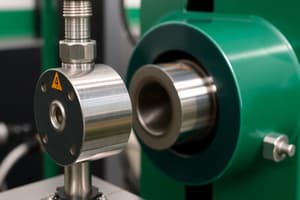Podcast
Questions and Answers
What is a primary purpose of a phase diagram in metallurgy?
What is a primary purpose of a phase diagram in metallurgy?
- To show which phase(s) of a material exist at equilibrium under certain conditions (correct)
- To display the hardness testing results of different metals
- To represent the tensile strength of various alloys
- To illustrate the corrosion resistance of materials over time
Which structure forms at the eutectoid point in the Fe-C phase diagram?
Which structure forms at the eutectoid point in the Fe-C phase diagram?
- Cementite
- Pearlite (correct)
- Austenite
- Martensite
How can micro-segregation be effectively minimized during the solidification of Cu-Ni alloys?
How can micro-segregation be effectively minimized during the solidification of Cu-Ni alloys?
- By introducing high concentrations of carbon
- By stirring during solidification (correct)
- By adding external pressure during melting
- By increasing the cooling rate
Which of the following is true regarding martensite in the context of phase diagrams?
Which of the following is true regarding martensite in the context of phase diagrams?
What is the significance of the solidus and liquidus lines in a simple binary phase diagram?
What is the significance of the solidus and liquidus lines in a simple binary phase diagram?
What is the primary purpose of a tensile test on a material specimen?
What is the primary purpose of a tensile test on a material specimen?
Which of the following equations correctly defines engineering stress?
Which of the following equations correctly defines engineering stress?
Which mechanical property is directly assessed through the tensile stress-strain curve?
Which mechanical property is directly assessed through the tensile stress-strain curve?
What phenomenon does necking in a tensile specimen indicate?
What phenomenon does necking in a tensile specimen indicate?
What happens to engineering strain as the elongation of the material increases?
What happens to engineering strain as the elongation of the material increases?
When a force is applied parallel to the surface of a material, which type of stress is induced?
When a force is applied parallel to the surface of a material, which type of stress is induced?
In the context of mechanical properties, what does toughness specifically refer to?
In the context of mechanical properties, what does toughness specifically refer to?
What is the term used to describe the gradual degradation of materials due to constant loading over time?
What is the term used to describe the gradual degradation of materials due to constant loading over time?
What is the formula for shear stress?
What is the formula for shear stress?
In tensile testing, what does the strain rate represent?
In tensile testing, what does the strain rate represent?
What is the definition of hydrostatic pressure?
What is the definition of hydrostatic pressure?
Which of the following best describes the elastic region in stress/strain graphs?
Which of the following best describes the elastic region in stress/strain graphs?
What does Young's Modulus measure?
What does Young's Modulus measure?
Above which point do stress and strain begin to deviate from linearity on a stress/strain graph?
Above which point do stress and strain begin to deviate from linearity on a stress/strain graph?
What characterizes tension, shear, and compression stress?
What characterizes tension, shear, and compression stress?
When a material returns to its original shape after stress is removed, it is said to have high:
When a material returns to its original shape after stress is removed, it is said to have high:
What is the relationship defined by Hooke's Law?
What is the relationship defined by Hooke's Law?
What happens when shear strain is approximated to angle θ for small strains?
What happens when shear strain is approximated to angle θ for small strains?
What is the main characteristic of martensite formed by quenching steel?
What is the main characteristic of martensite formed by quenching steel?
Which cooling method results in the highest yield strength and hardness of steel?
Which cooling method results in the highest yield strength and hardness of steel?
What is the effect of tempering on martensite?
What is the effect of tempering on martensite?
Which feature distinguishes steels with different carbon content?
Which feature distinguishes steels with different carbon content?
During slow furnace cooling of steel, what microstructural characteristic is observed?
During slow furnace cooling of steel, what microstructural characteristic is observed?
What is the defining microstructural feature of low-carbon (mild) steel?
What is the defining microstructural feature of low-carbon (mild) steel?
Which statement about the microstructure of quenched steel is true?
Which statement about the microstructure of quenched steel is true?
Which of the following describes the outcome of natural cooling (normalising) of steel?
Which of the following describes the outcome of natural cooling (normalising) of steel?
What should be considered when tempering martensite for optimal properties?
What should be considered when tempering martensite for optimal properties?
What is a common misconception about the relationship between cooling rate and steel's microstructure?
What is a common misconception about the relationship between cooling rate and steel's microstructure?
What is the relationship between stiffness and elastic modulus?
What is the relationship between stiffness and elastic modulus?
What is the value of Poisson's Ratio for most materials under axial strain?
What is the value of Poisson's Ratio for most materials under axial strain?
Under what condition does a microstructure consist solely of pearlite?
Under what condition does a microstructure consist solely of pearlite?
What defines the transverse strain in relation to Poisson's Ratio?
What defines the transverse strain in relation to Poisson's Ratio?
What is the result of applying pressure to a material in terms of dilation?
What is the result of applying pressure to a material in terms of dilation?
What structural form does iron (Fe) exhibit at room temperature?
What structural form does iron (Fe) exhibit at room temperature?
How does the yield stress of ferrite compare to austenite?
How does the yield stress of ferrite compare to austenite?
What percentage of carbon can dissolve in ferrite at room temperature?
What percentage of carbon can dissolve in ferrite at room temperature?
Which statement is true regarding the layers in pearlite microstructure?
Which statement is true regarding the layers in pearlite microstructure?
What will happen to the microstructure if carbon content exceeds 0.76%?
What will happen to the microstructure if carbon content exceeds 0.76%?
Flashcards
Phase diagram
Phase diagram
A diagram that shows which phases of a material exist at equilibrium under specific conditions like temperature and composition.
Eutectoid point
Eutectoid point
A mixture of two or more phases that forms at a specific temperature and composition.
Micro-segregation
Micro-segregation
The process of solidifying an alloy over a range of temperatures, resulting in a non-uniform distribution of elements within a single grain.
Martensite
Martensite
Signup and view all the flashcards
Pearlite
Pearlite
Signup and view all the flashcards
Stiffness
Stiffness
Signup and view all the flashcards
Strength
Strength
Signup and view all the flashcards
Toughness
Toughness
Signup and view all the flashcards
Hardness
Hardness
Signup and view all the flashcards
Tensile Force
Tensile Force
Signup and view all the flashcards
Tensile Stress
Tensile Stress
Signup and view all the flashcards
Tensile Strain
Tensile Strain
Signup and view all the flashcards
Shear Force
Shear Force
Signup and view all the flashcards
Shear stress
Shear stress
Signup and view all the flashcards
Shear strain
Shear strain
Signup and view all the flashcards
Pressure (in solids)
Pressure (in solids)
Signup and view all the flashcards
Dilation
Dilation
Signup and view all the flashcards
Strain rate
Strain rate
Signup and view all the flashcards
Elastic region
Elastic region
Signup and view all the flashcards
Yield point
Yield point
Signup and view all the flashcards
Young's Modulus (E)
Young's Modulus (E)
Signup and view all the flashcards
Hydrostatic pressure
Hydrostatic pressure
Signup and view all the flashcards
Cooling Rate
Cooling Rate
Signup and view all the flashcards
Furnace Cooling
Furnace Cooling
Signup and view all the flashcards
Furnace Cooled Steel Microstructure
Furnace Cooled Steel Microstructure
Signup and view all the flashcards
Air Cooling (Normalizing)
Air Cooling (Normalizing)
Signup and view all the flashcards
Air Cooled Steel Microstructure
Air Cooled Steel Microstructure
Signup and view all the flashcards
Quenching
Quenching
Signup and view all the flashcards
Tempering Martensite
Tempering Martensite
Signup and view all the flashcards
Tempered Martensite Microstructure
Tempered Martensite Microstructure
Signup and view all the flashcards
Steel Classification
Steel Classification
Signup and view all the flashcards
Hooke's Law
Hooke's Law
Signup and view all the flashcards
Elastic Modulus (E)
Elastic Modulus (E)
Signup and view all the flashcards
Shear Modulus (G)
Shear Modulus (G)
Signup and view all the flashcards
Bulk Modulus (K)
Bulk Modulus (K)
Signup and view all the flashcards
Poisson's Ratio (ν)
Poisson's Ratio (ν)
Signup and view all the flashcards
Ferrite
Ferrite
Signup and view all the flashcards
Austenite
Austenite
Signup and view all the flashcards
Yield Stress
Yield Stress
Signup and view all the flashcards
Study Notes
Mechanical Properties
- Mechanical properties of interest include stiffness, strength, toughness, and hardness.
- Materials can degrade through wear, creep, fatigue, or corrosion.
Tensile Forces
- Tensile tests involve applying tensile stress to a material sample.
- This typically involves pulling on the ends of the sample to stretch it.
- Force (F) and elongation (ΔL) are measured.
- Tensile testing machines apply force at a constant rate.
- Test specimens usually have parallel sides and equal cross-sections for consistent measurements.
- Plotting tensile force against elongation gives useful data.
Stress-Strain Curves
- Stress-strain curves vary depending on the material.
- As strain increases, stress may increase, decrease, or remain constant.
- The point of breaking is also part of the curve.
- Tensile stress is pulling a sample in a direction perpendicular to its surface.
- Compressive stress is pushing a sample in a direction perpendicular to its surface.
- Forces can be resolved if they are acting at an angle to its surface.
Shear Stress/Strain
- Shear stress causes sliding, or shear strain.
- Shear stress is defined by the force divided by the area.
- Shear strain is the ratio of the sideway shift to the length of the material edge.
Pressure
- When a solid is subjected to equal compression on all sides, it experiences pressure.
- Pressure is the force divided by area.
- Pressure also causes a change in volume.
Elastic Deformation
- Materials deform in tensile, compressive, and bending tests.
- Understanding elastic deformation is important for many engineering applications.
Stress/Strain Graph Regions
- Stress/strain graph regions include elastic and plastic regions.
- The elastic region occurs before the yield point at less than 1% of the plastic region.
- In the elastic region, the material recovers its original shape after the force is removed.
- The plastic region occurs after the yield point, leading to permanent deformation.
- The relationship between stress and strain in the elastic region follows Hooke's law.
Stiffness
- Stiffness measures a material's ability to return to its original shape after a force is removed.
- Stiffness is directly proportional to the elastic modulus.
- Axial stiffness relates to tensile or compressive elements.
Young's Modulus
- Young's Modulus (E) is the slope on a stress-strain graph in the elastic region.
- It is related to the material's stiffness.
- It can be calculated by dividing stress by strain.
Hooke's Law
- Hooke's law represents the linear relationship between stress and strain in the elastic region.
- It states stress is directly proportional to strain.
Poisson's Ratio
- Poisson's ratio (v) describes how much a material will contract in one direction when stretched in another.
- It is the ratio of the lateral strain to the axial strain.
Elastic Energy
- The area under a stress-strain curve represents the elastic energy.
- This represents the energy needed to deform the material in the elastic region.
Bending Tests
- Bending is a type of deformation.
- Bending is described by deflection and stress.
- Bending applies a larger stress than tension in the same material.
Fracture
- Material fracture occurs when the internal stresses are exceeding the material's strength.
- The fracture point is often marked on a stress/strain graph.
- Ductile fracture occurs after significant plastic deformation.
- Brittle fracture occurs with little plastic deformation.
Toughness and Fracture Toughness
- Toughness is the ability of a material to absorb energy before fracturing.
- Fracture toughness is the ability of a material to resist crack propagation.
- Brittle materials absorb little energy, while ductile materials absorb more.
Atomic Bonding
- Different types of atomic bonds affect material properties.
- These include strong bonds like metallic bonds and weak bonds like hydrogen and van der waals bonds, and covalent bond.
- Material structure, bond properties, and history can all affect material toughness.
Microstructure
- Microstructures such as grain size and precipitates are important in strength.
- The smaller the grain size the stronger the material.
- Precipitate particles also hinder motion improving strength.
Solid Solution Strengthening
- Solid solution strengthening occurs when different types of atoms of an element are dissolved in the lattice structure of another element.
- Substitutional solid solutions occur when atoms of the same size are mixed.
- Interstitial solid solutions occur when small atoms are mixed with large atoms filling the spaces.
- This creates local stress fields making plastic deformation difficult.
Cold Working
- Cold working is increasing the material's strength at room temperature.
- Increasing stress and strain cause local deformation, which decreases ductility and increases strength.
- Cold working is also responsible for making the dislocation move more difficult and therefore the yield strength to increase.
Annealing
- Annealing is a process for reducing hardness and increasing ductility of metal.
- Heating and then cooling the metal causes recrystallization forming new, larger grains.
- This reduces internal stress, improving grain uniformity.
- The result is a stronger, less brittle material.
Tempering
- Tempering increases toughness by introducing grain boundaries.
- Heating steel to a specific temperature followed by cooling controls the microstructure and the properties of the steel.
Phase Diagrams
- Phase diagrams represent the equilibrium conditions for different phases of a material.
- Different phases appear in different conditions which affect the properties of the mixture.
- Understanding phase diagrams helps predict microstructure developments in alloy solidification.
Studying That Suits You
Use AI to generate personalized quizzes and flashcards to suit your learning preferences.




